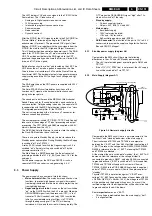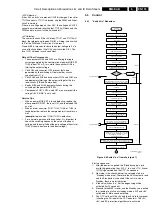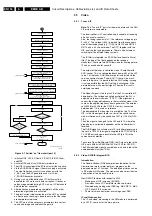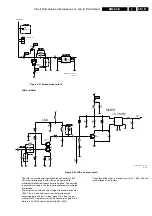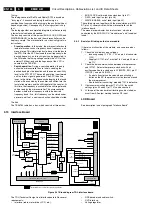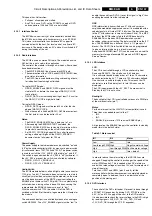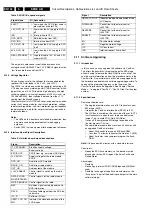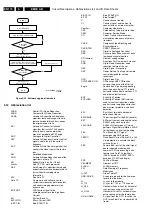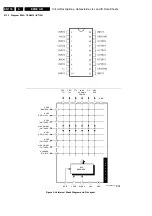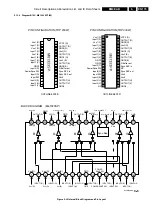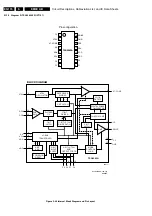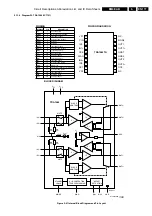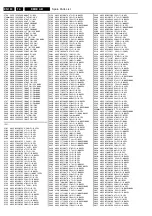
Circuit Descriptions, Abbreviation List, and IC Data Sheets
9.
mode to activate the microcontroller initiated "mute". This
"mute" must be used during the frequency setting and during
the standby mode.
Power save mode: The main supply can be switched off with
the “power save” control line to reduce the current
consumption. The microcontroller is always powered by the
power supply. All other electronics can be put into power save
mode.
After approx. 10 minutes of no "Tuned" signal the receiver goes
into power save mode. Once in power save mode, the receiver
is operated in “listen-sleep” mode to reduce the average
current consumption.
Power Supply
The board is having a low drop voltage regulator 7790, which
has an output voltage of 8 Vdc.
The 5 Vdc supply for the micro controller is extracted from the
10 Vdc input supply via a zenerdiode 6751. The 5 Vdc supply
of the synthesizer is extracted from transistor 7606. The
POWERSAVE signal is also provided to the connector for the
amplifier.
9.7.5
Amplifier (Diagram W)
General
The amplifier module delivers 2 x 15 Watt into 4 ohm speakers.
There is an incorporated high-pass filter because of the use of
soft-flat panels as speaker. The speakers are connected
through 2.5 mm mono-jacks. The crossover will be around 150
Hz. The amplifier uses a “cool power” amplifier IC
(TDA1564TH).
The module is featured with an additional “wired backup” input
(3.5mm stereo-jack) and a 2-colour LED indicator. Green
indicates the active state, red is standby. There is also an on-
board 10 Vdc regulator, specially intended for the TX receiver.
DC-references and Supply
The reference voltage used in the preamp-filter is made of the
internal reference of the amplifier chip TDA1564TH. This
reference is buffered by 7100-D and present on pin 14 of 7100-
D. The reference is only valid when the chip is active or muted.
The power supply for the pre-amp is made by using the filter
circuitry 3100, 2101, and 2100. This supply is 10.6 Vdc for all
operating conditions.
The built-in voltage regulator LM317MDT delivers 10 Vdc for
the receiver board. The 10 Vdc is set by 3141 and 3142. This
is the normal operating condition by wireless use of the whole
set.
This 10 Vdc supply can be switched "off" by connecting a 3.5
mm plug into the "wired backup" input. By doing so, the base of
7103 is connected to ground, 7111 is saturated, and pin 1 of
7110 is on ground level. The result is 1.25 Vdc on the supply
line to the receiver.
Mute Circuitry
In normal operating circumstances, the voltage on the MODE
pin of the amplifier will be 9.7 Vdc. Transistors 7104 and 7107
are not saturated at that moment. When the receiver generates
a ”mute” (4 Vdc on pin 6 of connector 1106), then 7107 will
saturate and pulls down the level on pin 2 of 7101 to 2.3 Vdc.
All DC-references stay as they were, the LED stays green, but
no sound is produced on the outputs.
When the receiver goes into "power save" mode (when 10
minutes no signal from the TV set), the circuitry around 7104
pulls the mute line down to nearly 0 V. In this condition, the
amplifier is completely in "standby" mode, while all DC-
references are disabled. The LED red will be "on", while green
is "off".
When the receiver detects a valid signal from the TV set, the
POWERSAVE line becomes continuously "low", and after a
small time (2137, 3133, 7104) 7104 is turned "off". At the same
moment, the mute line becomes "low" and the amplifier is
enabled again.
Amplifier considerations
The 26 dB amplifier TDA1564TH operates on 13 Vdc and can
deliver 2 x 15 Watts into 4 ohm loads. The dissipation is
minimized by internally switching in the TDA1564 from Single
Ended (SE) to Bridge Tied Load (BTL) mode, only when a
higher output voltage swing is needed.
Input signals from the receiver (or the 3.5 mm stereo jack) input
are filtered in the two-section high pass filter around 7100-B
and 7100-A. This is needed because the flat panel speakers
cannot reproduce low frequency sound. The -3 dB point is
somewhere around 150 Hz.
Input sensitivity of the amplifier for maximum output:
•
Wireless use (signals coming from the receiver board):
typical 1.4 V_rms
•
Wired use (signals coming from the 3.5 mm jack input):
typical 2.5 V_rms
9.8
Tuner Board
9.8.1
General
The ECO6 tuner module is an electronic controlled digital
tuner. It is an economic version of the TUNER 92 (economic
means: no special front-end unit, new designed radio IC).
9.8.2
Key Components
•
Tuner front end: FE450.
•
Radio IC: TEA5762.
Tuner front end
Figure 9-30 Block diagram tuner front-end
This is a ready made and trimmed unit.
Radio IC TEA5762
This IC is a 44 pins monolithic integrated AM-receiver and FM-
IF part with demodulator and stereo decoder. It is designed for
the use with an external FM front-end.
It incorporates internal stabilised power supplies that allow a
wide supply voltage range from 2.5 V up to 12 V without any
loss of performance.
The radio
For FM operation, an external FM front-end is necessary. This
is switched "on" and "off" by the FM_ON/OFF signal which is
generated in the bus system.
The AFC circuit in the TEA5762 provides a tuning voltage to
drive the VCO of the external FM front-end.
The frequency of the external VCO is counted in the Self Tuned
Radio (STR) tuning system.
The FM-IF circuit is designed for distributed IF ceramic filters
(items 5109 and 5110). The FM quadratic detector uses a
ceramic resonator.
The PLL stereo decoder incorporates a signal dependent
stereo-blend circuit and a soft-mute circuit.
Fa = 100MHz
Fo = 110.7MHz
Fif = 10.7MHz
Fo
110.7MHz
10.7MHz = 110.7 - 100
10.7MHz = 121.4 - 110.7 (mirror)
Fa
100MHz
Fif
10.7MHz
AGC
Osc
Vt
Fa = 100MHz
=
=
+
+
CL 36532049_002.eps
060603

